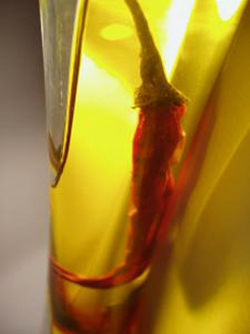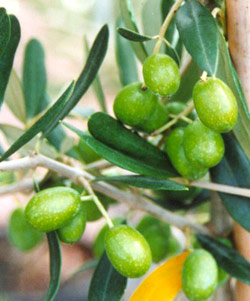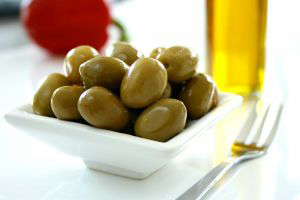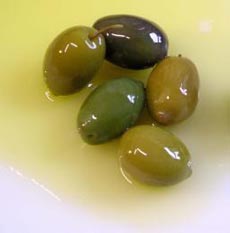Olive Oil & Olives Glossary
Page 4: Terms With F & G
This is Page 4 of the Olive Oil & Olives Glossary. If you think we should consider terms or definitions than those we have provided, use the Contact Us links on this page. Also read our article, Flavors and Aromas of Olive Oil. Visit our collection of 60+ food glossaries to learn more about other food products.
You can click on the letter of the alphabet in the bar below to get to a term
without having to scroll manually.
a b c d e f g h i j k l m n o p q r s t u v w x y z
This glossary is protected by copyright and cannot be reproduced in whole or part.
FLAVORED OLIVE OIL
 Not to be confused with infused olive oil, here the oil has been flavored with an agent such as an alcohol-based flavor extract. A heat treating process is often used to infuse the oil with flavoring agents. Basil, chile, garlic, lemon and rosemary. Note the quality of the the base oil used; it may often be simple refined olive oil, not virgin or extra virgin olive oil, as with infused oils. Not to be confused with infused olive oil, here the oil has been flavored with an agent such as an alcohol-based flavor extract. A heat treating process is often used to infuse the oil with flavoring agents. Basil, chile, garlic, lemon and rosemary. Note the quality of the the base oil used; it may often be simple refined olive oil, not virgin or extra virgin olive oil, as with infused oils.
Photo by David Lee | SXC.
FINO OLIVE OIL
A blend of extra virgin and virgin oils (fino is Italian for “fine”).
FIRST PRESS
IOOC Definition: First press is no longer an official definition for olive oil. A century ago, oil was pressed in screw or hydraulic presses. The paste was subjected to increasingly high pressures with subsequent degradation in the flavor of the oil. Today the vast majority of oil is made in continuous centrifugal presses. There is no second pressing.
FRANTOIO OLIVE
 The primary olive planted in Italy, the Frantoio is one of the four olives in the classic Tuscan blend (along with the Leccino, the Moraiolo and the Pendolino). The olive produces a fruity oil with a lighter taste. It has a scent of green leaves and grass, a hint of green apple and almond layered onto the olive fruitiness and a wee amount of bitterness, pungency and astringency. Overall, it’s a sweet olive oil with average stability. The primary olive planted in Italy, the Frantoio is one of the four olives in the classic Tuscan blend (along with the Leccino, the Moraiolo and the Pendolino). The olive produces a fruity oil with a lighter taste. It has a scent of green leaves and grass, a hint of green apple and almond layered onto the olive fruitiness and a wee amount of bitterness, pungency and astringency. Overall, it’s a sweet olive oil with average stability.
Frantoio olive trees can be purchased at
Olive-Trees.net.
FRESHNESS
For the freshest oil possible, know when your olives are picked. For example, in Italy, olives are picked in most regions beginning from mid-October through early November; with some cultivars the picking can continue into December and January. Olives are pressed within 24 to 48 hours after harvest, and bottled soon afterwards. So, a retailer should receive the new harvest oil’s in January or February. Look for it then. Oil from olives harvested the southern hemisphere (e.g. Australia) will arrive in the summer.
FRUIT
The olive is the fruit of the olive tree. Not all tree fruits are sweet, nor are they immediately edible when picked ripe from the tree. Green or ripe, olives must be brined or cured before they are edible.
GAETA or GYETA OLIVE
This small, oval Italian olive has violet-purple flesh. Gaeta olives can be salt cured or brine cured; the salt-cured olives have wrinkled flesh and the brine-cured olives are smooth-fleshed. The olive is meaty, oily, and intense, with a somewhat tart to salty flavor. It is used in slow-cooked stews and braised dishes, fish dishes, salads, pasta and tapenade. As a table olive, it pairs well with hearty Zinfandels.
GORDAL OLIVE
Another name for the Sevillano olive.
GREEK OLIVES
The most popular Greek varieties include the Kalamata and the Koroneiki. Though strong tasting, Greek olives are not treated with lye. They are packed in dry salt, or pickled in brine for 6 to 12 months, where they undergo a process of lactic fermentation before they are packed in fresh brine.
GREEN OLIVES
Green olives are obtained from olives harvested during the ripening cycle when they have reached normal size, but prior to color change. They are usually hand-picked when there is a slight change in hue from leaf-green to a slightly yellowish green and  when the flesh begins to change consistency but before it turns soft. The olives are taken to the plant for processing on the same day if possible. While more oil is in the olive the darker it becomes, acidity increases at the same time; so the grower has to decide to pick exactly at the right time to maximize the oil while minimizing the acidity (the lower the acidity, the higher the grade of oil and the price it commands). Green olives are processed in two principal ways: with fermentation (Spanish or Sevillian style) and without fermentation (Picholine or American type). Green olives are often pitted and stuffed with savory fillings such as almonds, anchovies, blue cheese, capers, jalapeños, onions and, most popularly, pimientos (roasted red peppers). See also black olives. when the flesh begins to change consistency but before it turns soft. The olives are taken to the plant for processing on the same day if possible. While more oil is in the olive the darker it becomes, acidity increases at the same time; so the grower has to decide to pick exactly at the right time to maximize the oil while minimizing the acidity (the lower the acidity, the higher the grade of oil and the price it commands). Green olives are processed in two principal ways: with fermentation (Spanish or Sevillian style) and without fermentation (Picholine or American type). Green olives are often pitted and stuffed with savory fillings such as almonds, anchovies, blue cheese, capers, jalapeños, onions and, most popularly, pimientos (roasted red peppers). See also black olives.
Photo of green olives by Steve Woods | SXC.
GRADES OF OLIVE
Olives are graded into sizes based on either diameter (American standards) or number per kilo or pound (international standards). There are more than 15 grades, from Sub Petite (181 to 220 olives per pound) to Super Mammoth (41-45 olives per pound). In-between are Small, Medium, Large, Extra Large, Jumbo, Extra Jumbo, Giant, Colossal, Super Colossal, Mammoth and other designations that will eternally puzzle olive buyers until labeling includes the number of olives per pound so consumers know the difference among Extra Jumbo, Giant, Colossal, Mammoth, etc.
Continue To Next Page: Terms With H To K
Go To The Article Index Above
Lifestyle Direct, Inc. All rights reserved. Images are the copyright of their individual owners.

|






 The primary olive planted in Italy, the Frantoio is one of the four olives in the classic Tuscan blend (along with the
The primary olive planted in Italy, the Frantoio is one of the four olives in the classic Tuscan blend (along with the  when the flesh begins to change consistency but before it turns soft. The olives are taken to the plant for processing on the same day if possible. While more oil is in the olive the darker it becomes, acidity increases at the same time; so the grower has to decide to pick exactly at the right time to maximize the oil while minimizing the acidity (the lower the acidity, the higher the grade of oil and the price it commands). Green olives are processed in two principal ways: with fermentation (
when the flesh begins to change consistency but before it turns soft. The olives are taken to the plant for processing on the same day if possible. While more oil is in the olive the darker it becomes, acidity increases at the same time; so the grower has to decide to pick exactly at the right time to maximize the oil while minimizing the acidity (the lower the acidity, the higher the grade of oil and the price it commands). Green olives are processed in two principal ways: with fermentation (